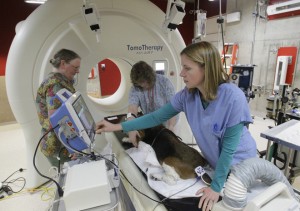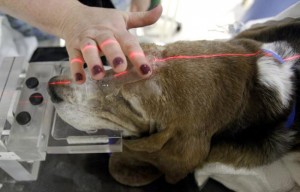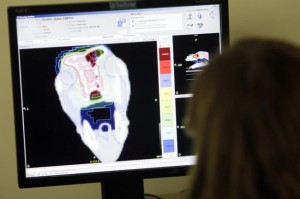Clyde, gets state of the art treatment at the University of Wisconsin Veterinary School:)
Howllo Fellow Basset Hound and cutting technology lovers! Well, it sure sounds like the University of Wisconsin Veterinary School is one of those!
Resident veterinary anesthesiologist Carrie Schroeder (foreground) monitors Clyde, while technicians Joan Capelle (left) and Cheryl Bohling prepare him for treatment last week.
Pets treated to cutting-edge therapy
By Meg Jones of the Journal Sentinel
Lying on a soft white blanket while waiting to get prepped for his medical treatment, Clyde looked bummed as he softly moaned.
It wasn’t clear whether he knew what lay in store for him. Clyde is a basset hound. Like most members of his breed, he always has a “hangdog look.”
On this day, 10-year-old Clyde was undergoing one in a series of TomoTherapy treatments for the cancerous tumor in his nose. He is one of the first pets to be treated by the relatively new radiation therapy at the University of Wisconsin School of Veterinary Medicine, the first veterinary school in the nation to open a TomoTherapy clinic.
TomoTherapy delivers radiation in slices – the Greek prefix “tomo” means slice – focusing the beam more narrowly on the tumor without harming surrounding tissue and organs. Developed at the University of Wisconsin-Madison, it provides a combination of radiation treatment with a helical CT scanner in equipment built by TomoTherapy Inc., a Madison-based radiation therapy firm.
In a way TomoTherapy has come full circle at the UW veterinary school because animals here were used in clinical trials with their owners’ permission to test the procedure before it was used on humans. Dogs with nasal tumors are similar biologically to humans with head and neck tumors, said Lisa Forrest, a radiation oncologist and researcher at the UW veterinary school.
TomoTherapy differs from conventional cancer treatments that have been used for decades because instead of blasting the whole tumor with radiation, and quite often harming healthy tissue, the treatment pinpoints the tumor. Dogs with nasal tumors often ended up losing sight in one or both eyes or suffering from dry eyes from the radiation treatments, leaving their owners with difficult decisions to make regarding quality of life for their pets.
“The thing with nasal tumors is we don’t discover them until they’re quite big because the dog or cat can’t say ‘Hey, I’m having trouble breathing,’ ” Forrest said
Nasal tumors are common in dogs, particularly retrievers, as well as cats. When cats can’t smell, it’s harder to get them to eat. Clyde’s owner Christine Cary first noticed one of his nostrils began plugging up with mucus in October. Clyde’s face was tender, and he sometimes yelped when petted in that area.
After seeing two veterinarians and learning that surgery was not an option, Cary was referred to UW, where she and her husband learned about the new TomoTherapy clinic. They drive 130 miles round trip each weekday while Clyde goes through 10 treatments, which last about 45 minutes, including 15 minutes or less in the TomoTherapy machine.
Costly treatment
It’s not cheap. The cost is based on the tumor type and size and ranges from $1,500 to $7,000, said Ruthanne Chun, associate dean for clinical affairs and director of the UW Veterinary Medical Teaching Hospital. Most pet owners pay the full cost since few have insurance for their animals.
“We were kind of on the fence because of his age and yet we were hoping, after talking to the oncologist, to get another year out of him,” said Cary, who is using money she earned working as seasonal help at Lands’ End to pay for Clyde’s treatment.
On this day, Clyde was third in line after Bushes and Oscar and before Dukie, Jesse, Heidi, Chance and Ellie. Except for Bushes, a black domestic shorthair cat, all of the patients were dogs.
Clyde was given a shot to put him to sleep, then intubated with a breathing tube and hooked up to an anesthesia machine by Carrie Schroeder, an anesthesia resident. A pulse monitor, which normally goes on an adult human’s finger, was placed on Clyde’s tongue. Then Clyde was wheeled into the concrete-lined room and placed on the TomoTherapy equipment, splayed on his stomach with his furry head pointing toward the large doughnut-shaped machine, his mouth clamped on to a hard rubber bite block.
Soon the machine was sending a beam of radiation through the tumor.
With TomoTherapy “we preserve their eyesight, we prevent them from getting dry eye,” said Forrest, who is also a radiologist. “We’re able to shape the beam to the tumor.”
UW national leader
Chun noted that UW is already a leader in oncology treatment for animals and draws pet owners from throughout the Midwest and farther away. Other veterinary schools, such as Texas A&M, are planning on opening TomoTherapy clinics, but because of the expense it’s likely only a handful of veterinary hospitals will eventually have them. For that reason, Chun said, Madison will probably get more pets from as far away as the coasts as word of the UW TomoTherapy clinic spreads.
“As veterinary oncologists, our goal is to make the quality of life great, and with TomoTherapy we can do that,” Chun said.
The clinic, which took a year to build, cost about $5 million and was paid entirely through gift funds. It can handle animals ranging from rabbits to Great Danes though not horses, which are too big for the equipment.
Cathy Brown brought her 13-year-old golden retriever, Jesse, for treatment of a nasal tumor and a small tumor in his brainstem. Jesse was the first animal treated at the UW TomoTherapy Clinic.
She took him to her veterinarian in Madison in late November after noticing a discharge coming from his nose, and later a neurologist told her that the nasal tumor was quite large. When she learned the TomoTherapy clinic was opening soon, she decided to take Jesse for treatment since it was possible he would lose his eyesight with conventional radiation therapy.
“I knew the first option wasn’t an option because he still had a good quality of life,” she said as she waited for Jesse to finish treatment. “I knew the Wisconsin veterinary school had one of the best cancer treatment centers, and I’m not surprised they would be on the cutting edge”.
End of article…
Get well soon Clyde….
More loving the cutting edge later…..Cat, Chaps and Emma



 Comments(8)
Comments(8)




I hope Clyde will come through this with flying colors.
Amazing!!
Wow. This is great that they are progessing so well with taking care of our pets.
Good luck Clyde!
go clyde! go clyde’s owners!!!
Thanks for finding this article. I suspect (am sure) the reason UW has state of the art pet oncology facilities is due to warfarin – the rat poison. UW owns the patent for that product and uses the proceeds to fund their research at the school.
Many years ago the school was successful in keeping the money out of the hands of the Legislature (which just happens to be one mile down the mall from the school.(They can see the whites ( dollar signs) of each others eyes) And when I was there 30 years ago they had built a 13 story building for administration of the funds.
Because once the school found out how to keep the legislature from getting their hands on the money, they started patenting everything they developed in Agriculture, Engineering, etc. to continue their research work. Wonder what other things industry uses have been developed there.
And the court said the legislature still had to fund the regular costs for the university!
Always thought that was a cool story most people don’t know.
Mary
Mary – I am not sure I understand. Is the University in the right or wrong? I do find this very interesting! Please tell more!
Cat
Cat,
I think the courts opinion was that the research to develop the warfarin and other things they have created were not part of the legislature funding. Most schools get grants from other sources for their research, not from the state. The state funds pay for the profs to teach, not do research. There is usually a 3rd party footing the bill and there are no strings attached either, although the 3rd party hopes to reap the benefits of the problem’s solution.
Also, if the state got the $$, it would be in general fund, not used for more research. I think it was a good decision on the part of the WI courts.
And the research the school is doing is never something off-the-wall. It is usually related to finding solutions to problems in industry, agriculture or engineering. I think warfarin was developed for farmers with rat problems, but has helped people throughout the world to reduce the occurrence and spread of diseases.
Sorry I don’t remember more. I was only there for a year while my ex. was in school and that was 30 years ago!
Mary
That makes it a bit more clear. The same thing is happening now with a glaucoma study in basset hounds. I know of 2 Universities that are in a race to find the “mutant” gene that will allow breeders to buy a test kit and determine if they should breed a pair. This is all in it’s early phases. This would be the by product of the research that is actually designed to benefit humans.
Some basset hound breeders were actually breeding glaucoma into their line totally ignoring all of the warning signs. I could go on and on with this topic which I have in a subblog.
Thanks Mary…
Cat